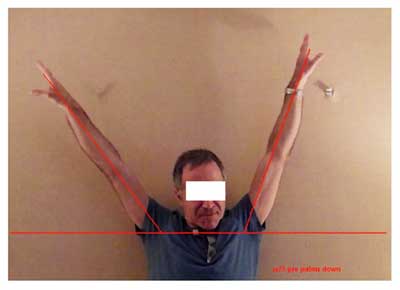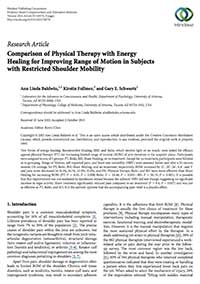Энн Линда Болдуин, Кирстин Фуллмер, Гарри Шварц. Сравнение физической терапии и целительской энергии для улучшения диапазона движения пациентов с ограниченной подвижностью плеча (перевод в сокращении).
Baldwin A.L., Fullmer K., Schwartz G.E. Comparison of Physical Therapy with Energy Healing for Improving Range of Motion in Subjects with Restricted Shoulder Mobility. Evidence-Based Complementary and Alternative Medicine. Volume 2013: Article ID 329731, 2013.
Цель исследования: определить, является ли необходимым для успешного краткосрочного лечения ограниченного диапазона движения плеча (ДДП) возвышение руки в лопаточной плоскости в ходе мануальной терапии.Гипотезы. Мануальная манипуляция (совместная мобилизация, отвлечение по длинной оси, деликатное восстановление) была испытана в сравнении с Reconnective Healing (энергетический метод лечения путем восстановления связи) и Рэйки у больных с ограниченным диапазоном движения плеча (ДДП). Два последних метода лечения включают только отсутствие прикосновения или легкое прикосновение, поэтому, если они настолько же эффективны, как и ручное манипулирование для улучшения ДДП, это означает, что ручное манипулирование само по себе не является необходимым для облегчения этого конкретного нарушения.
Методы. Для исследования были набраны люди с ограниченным диапазоном движения одного или обоих плеч (37 мужчина, 41 женщина) и отнесены к одной из пяти групп лечения: 1) Reconnective Healing (RH) 2) Рэйки, 3) Фиктивное лечение, 4) Физическая терапия, 5) Контрольная группа (без воздействия). Все испытуемые кроме контрольной группы не знали в какой конкретно они группе находятся и получили по 10 минут воздействия (слепой метод). Всем терапевтам и фиктивным терапевтам сказали, что испытуемые имели ограниченный диапазон движения плеча (ДДП) в результате травмы плеча или артрита.
 Измерялись максимальная ДДП (оценка по местной съемке), частота сердечных сокращений и оценка боли по стандартизованной шкале. Все оценки были измерены до и после лечения, анализировалась статистическая зничимость различий. Это исследование заимствовало экспериментальную схему другого исследования, в котором акупунктуре или Рэйки подвергалась культура клеток донора в колбе в сравнении с культурами, подвергавшимися фиктивному воздействию или его отсутвию. В той серии воздействие осуществлялось до или после того, как колбы с культурами подверглись рентгеновскому облучению или воздействию радиации. Иглоукалывание выглядело как вставка иглы из стандартной стали в колбу клеток в течение 20 мин (контрольная группа не получила иглы или получала уколы деревянной зубочисткой), Рэйки давал целитель, держащий руки над колбой (без прикосновением) с намерением передать энергию клеткам. Сравнивалась выживаемость клеток с помощью подсчета колоний через 10 дней после воздействия.
Измерялись максимальная ДДП (оценка по местной съемке), частота сердечных сокращений и оценка боли по стандартизованной шкале. Все оценки были измерены до и после лечения, анализировалась статистическая зничимость различий. Это исследование заимствовало экспериментальную схему другого исследования, в котором акупунктуре или Рэйки подвергалась культура клеток донора в колбе в сравнении с культурами, подвергавшимися фиктивному воздействию или его отсутвию. В той серии воздействие осуществлялось до или после того, как колбы с культурами подверглись рентгеновскому облучению или воздействию радиации. Иглоукалывание выглядело как вставка иглы из стандартной стали в колбу клеток в течение 20 мин (контрольная группа не получила иглы или получала уколы деревянной зубочисткой), Рэйки давал целитель, держащий руки над колбой (без прикосновением) с намерением передать энергию клеткам. Сравнивалась выживаемость клеток с помощью подсчета колоний через 10 дней после воздействия.
Результаты. Большинство пациентов, которые получали физиоческую терапию, Рэйки или RH показали улучшенный ДДП; в среднем ДДП увеличился на 3°, 0,6°, 12°, 20° и 26° для контрольной группы, фиктивного лечения, физической терапии, Рэйки и RH групп соответственно, и соответствующие показатели боли уменьшились на 0%, 15,4%, 11,5%, 10,1% и 23,9%. Фиктивное лечение значительно снижало боль, но не улучшало ДДП; не было никаких существенных изменений ЧСС. Это исследование показало, что 10-минутный сеанс RH или Рэйки является столь же эффективным, как физическая терапия в улучшении ДДП у людей с ограниченной подвижностью плеча.
Сильные стороны. Исследование хорошо разработано и показывает очевидное положительное влияние целительских энергетических методов, указывает на необходимость дальнейшего изучения.
Недостатки. Одно из ограничений этого исследования состоит в том, что фиксировались единовременные эффекты одной 10-минутной сессии лечения без каких-либо последующих измерений. Необходимы дальнейшие исследования, чтобы определить, будет ли сохраняться лечебный эффект от 10-минутной RH или Рэйки сессии с течением времени, по крайней мере такое же время, как эфект от 10-ти минутной сессии физической терапии.
Список литературы
- M. Urwin, D. Symmons, T. Allison et al., “Estimating the burden of musculoskeletal disorders in the community: the comparative prevalence of symptoms at different anatomical sites, and the relation to social deprivation,” Annals of the Rheumatic Diseases, vol. 57, no. 11, pp. 649–655, 1998.
- S. Green, R. Buchbinder, and S. Hetrick, “Physiotherapy inter- ventions for shoulder pain,” Cochrane Database of Systematic Reviews, no. 2, Article ID CD004258, 2003.
- J. P. Iannotti, “Evaluation of the painful shoulder,” Journal of Hand Therapy, vol. 7, no. 2, pp. 77–83, 1994.
- P.J.McMahonandR.E.Sallis,“Thepainfulshoulder:zeroingin on the most common causes,” Postgraduate Medicine, vol. 106, no. 7, pp. 36–38, 41–43, 47–49, 1999.
- E. Naredo, P. Aguado, E. de Miguel et al., “Painful shoulder: comparison of physical examination and ultrasonographic findings,” Annals of the Rheumatic Diseases, vol. 61, no. 2, pp. 132–136, 2002.
- J. H. Stevenson and T. Trojian, “Evaluation of shoulder pain,” Journal of Family Practice, vol. 51, no. 7, pp. 605–611, 2002.
- K. M. Johansson, L. E. Adolfsson, and M. O. Foldevi, “Effects of acupuncture versus ultrasound in patients with impingement syndrome: randomized clinical trial,” Physical Therapy, vol. 85, no. 6, pp. 490–501, 2005.
- J. R. Andrews, “Diagnosis and treatment of chronic painful shoulder: review of nonsurgical interventions,” Journal of Arthroscopic and Related Surgery, vol. 21, no. 3, pp. 333–347, 2005.
- K. Bennell, S. Coburn, E. Wee et al., “Efficacy and cost- effectiveness of a physiotherapy program for chronic rotator cuff pathology: a protocol for a randomised, double-blind, placebo-controlled trial,” BMC Musculoskeletal Disorders, vol. 8, article 86, 2007.
- M. A. Campo, S. Weiser, and K. L. Koenig, “Job strain in physical therapists,” Physical Therapy, vol. 89, no. 9, pp. 946–956, 2009.
- M. Molumphy, B. Unger, G. Jensen, and R. B. Lopopolo, “Incidence of work-related low back pain in physical therapists,” Physical Therapy, vol. 65, no. 4, pp. 482–486, 1985.
- P. M. Barnes, B. Bloom, and R. L. Nahin, Complementary and Alternative Medicine Use among Adults and Children: United States, 2007, National Health Statistics Reports, Hyattville, Md, USA, 2008.
- L. Gill, “More hospitals offer alternative therapies for mind, body, spirit,” USA Today, September 2008, http://www.usatoday .com/news/health/2008-09-14-alternative-therapies N.htm.
- American Holistic Nurses Association and American Nurses Association, Holistic Nursing: Scope and Standards of Practice, Nursesbooks.org, Silver Spring, Md, USA, 2007.
- P. Miles and G. True, “Reiki—review of a biofield therapy history, theory, practice, and research,” Alternative Therapies in Health and Medicine, vol. 9, no. 2, pp. 62–72, 2003.
- S.JainandP.J.Mills,“Biofieldtherapies:helpfulorfullofhype? A best evidence synthesis,” International Journal of Behavioral Medicine, vol. 17, no. 1, pp. 1–16, 2010.
- A. L. Baldwin, A. Vitale, E. Brownell, J. Scicinski, M. Kearns, and W. Rand, “The touchstone process: an ongoing critical evaluation of Reiki in the scientific literature,” Holistic Nursing Practice, vol. 24, no. 5, pp. 260–276, 2010.
- N. Mackay, S. Hansen, and MA. McFarlane, “Autonomic ner- vous system changes during Reiki treatment: a preliminary study,” Journal of Alternative and Complementary Medicine, vol. 10, no. 6, pp. 1077–1081, 2004.
- A. Vitale, “An integrative review of Reiki touch therapy research,” Holistic Nursing Practice, vol. 21, no. 4, pp. 167–179, 2007.
- R.S.C.Friedman,M.M.Burg,P.Miles,F.Lee,andR.Lampert, “Effects of Reiki on autonomic activity early after acute coronary syndrome,” Journal of the American College of Cardiology, vol. 56, no. 12, pp. 995–996, 2010.
- B. Rubik, “The biofield hypothesis: its biophysical basis and role in medicine,” Journal of Alternative and Complementary Medicine, vol. 8, no. 6, pp. 703–718, 2002.
- A. Kirchner, H. Stefan, K. Bastian, and F. Birklein, “Vagus nerve stimulation suppresses pain but has limited effects on neurogenic inflammation in humans,” European Journal of Pain, vol. 10, no. 5, pp. 449–455, 2006.
- C. E. Henley, D. Ivins, M. Mills, F. K. Wen, and B. Ben- jamin, “Osteopathic manipulative treatment and its relationship to autonomic nervous system activity as demonstrated by heart rate variability: a repeated measures study,” Osteopathic Medicine and Primary Care, vol. 2, article 7, 2008.
- L. D ́ıaz-Rodr ́ıguez, M. Arroyo-Morales, C. Ferna ́ndez-de-las- Pen ̃as, F. Garc ́ıa-Lafuente, C. Garc ́ıa-Royo, and I. Toma ́s-Rojas, “Immediate effects of reiki on heart rate variability, cortisol levels, and body temperature in health care professionals with burnout,” Biological Research for Nursing, vol. 13, no. 4, pp. 376– 382, 2011.
- E. Pearl, The Reconnection: Heal Others Heal Yourself, Hay House, Carlsbad, Calif, USA, 1st edition, 2001.
- R. Z. Tashjian, J. Deloach, C. A. Porucznik, and A. P. Powell, “Minimal clinically important differences (MCID) and patient acceptable symptomatic state (PASS) for visual analog scales (VAS) measuring pain in patients treated for rotator cuff disease,” Journal of Shoulder and Elbow Surgery, vol. 18, no. 6, pp. 927–932, 2009.
- H.WalachandW.B.Jonas,“Placeboresearch:theevidencebase for harnessing self-healing capacities,” Journal of Alternative and Complementary Medicine, vol. 10, supplement 1, pp. S103–S112, 2004.
- O. Surenkok, A. Aytar, and G. Baltaci, “Acute effects of scapular mobilization in shoulder dysfunction: a double-blind random- ized placebo-controlled trial,” Journal of Sport Rehabilitation, vol. 18, no. 4, pp. 493–501, 2009.
- P. Teys, L. Bisset, and B. Vicenzino, “The initial effects of a Mulligan’s mobilization with movement technique on range of movement and pressure pain threshold in pain-limited shoulders,” Manual Therapy, vol. 13, no. 1, pp. 37–42, 2008.
- H. Vermeulen, P. Rozing, W. Obermann, S. Le Cessie, and T. P. M. V. Vlieland, “Comparison of high-grade and low- grade mobilization techniques in the management of adhesive capsulitis of the shoulder: randomized controlled trial,” Physical Therapy, vol. 86, no. 3, pp. 355–368, 2006.
- A. Johnson, J. Godges, G. Zimmerman, and L. Ounanian, “The effect of anterior versus posterior glide joint mobilization on external rotation range of motion in patients with shoulder adhesive capsulitis,” Journal of Orthopaedic and Sports Physical Therapy, vol. 37, no. 3, pp. 88–99, 2007.
- J. Yang, C. Chang, S. Chen, S.-F. Wang, and J.-J. Lin, “Mobi- lization techniques in subjects with frozen shoulder syndrome: randomized multiple-treatment trial,” Physical Therapy, vol. 87, no. 10, pp. 1307–1315, 2007.
- D. Conroy and K. Hayes, “The effect of joint mobilization as a component of comprehensive treatment for primary shoulder impingement syndrome,” Journal of Orthopaedic and Sports Physical Therapy, vol. 28, no. 1, pp. 3–14, 1998.
- A. F. Kachingwe, B. Phillips, E. Sletten, and S. W. Plunkett, “Comparison of manual therapy techniques with therapeutic exercise in the treatment of shoulder impingement: a ran- domized controlled pilot clinical trial,” Journal of Manual and Manipulative Therapy, vol. 16, no. 4, pp. 238–247, 2008.

